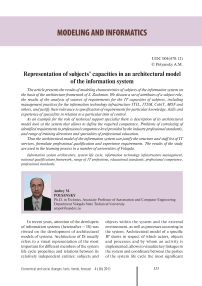Actual problems of small business development in the Khantia-Mansia autonomous okrug - Ugra
Автор: Bogomolova Lubov Leonidovna, Takmasheva Irina Veniaminovna
Журнал: Economic and Social Changes: Facts, Trends, Forecast @volnc-esc-en
Рубрика: Continuing the theme of the previous issue
Статья в выпуске: 4 (16) т.4, 2011 года.
Бесплатный доступ
The article examines the dynamics of the main indicators characterizing the activity of the small-scale enterprises in the Khantia-Mansia Autonomous Okrug. The article identifies the main problems of small-scale business in Ugra and determines the trends of the small businesses development in the okrug.
Small-scale business, small-scale enterprise, microenterprise, microfinance, subsidy, grant, credit
Короткий адрес: https://sciup.org/147223276
IDR: 147223276 | УДК: 334.012.64(470.5)
Текст научной статьи Actual problems of small business development in the Khantia-Mansia autonomous okrug - Ugra
Today small-scale business in the territory of the Russian Federation is an important social, political and economic factor that determines the overall development of the Russian economy in total.
Small and medium-sized enterprises make the main stratum of economy in the developed countries. For example, more than 90% of registered businesses in Finland are small and medium-sized enterprises; their share in the production of the country’s GDP is 50%. Only 1500 industrial enterprises produce 80% of GDP in the Russian Federation. It indicates the lack of development of small and mediumsized business.
Small-scale enterprises have a strong regional focus by virtue of their specific character.
Their activity is based primarily on the needs of the local market, volume and structure of local demand.
Small-scale business has the strongest influence over the Ugra local markets where it allows you to:
-
> use efficiently material, labor and financial resources and increase productivity;
-
> increase efficiency of commercial relations, intensify the production and displace inefficient production;
-
> diversify the local economy, develop the regional markets bringing goods and services nearer to consumers and equalize the living standards geographically;
-
> promote competitiveness;
-
> create additional jobs by lower cost than in large enterprises;
-
> increase the volume of products, expand the assortment and improve the quality of products;
-
> assimilate new technologies and promising markets;
-
> introduce new forms of industrial organization, financing and marketing.
Small-scale enterprises in the Khantia-Mansia Autonomous Okrug are concentrated in such socially important sectors as transport, communications, producing of building materials, construction, trade, services and domestic production.
Today some small enterprises which reflect the basic needs of consumers are developing. They are cafes, bakeries, restaurants, barbershops and beauty salons.
The most priority economic activities in the sphere of small-scale business in the autonomous okrug in 2010 were the following ones:
Э wholesale and retail trade, repair of motor vehicles, motorcycles, household goods and personal goods – 47.5%;
Э construction — 16.5%;
Э real estate, renting and business activities – 7.2%;
Э transport and communications — 14.6% (fig. 1) .
For comparison, the highest priority types of economic activity in the small-scale business in the in the territory of the Yamalia-Nenetsia Autonomous Okrug in 2010 were the following ones (the share of small enterprises):
Э construction — 34%;
Э wholesale and retail trade, personal services – 19%;
Э real estate — 13%;
Э transport and communications — 10%;
Э manufacturing activity — 8% (fig. 2) .
Figure 1. The highest priority types of economic activity in the small-scale business in the territory of the Khantia-Mansia Autonomous Okrug – Ugra in 2010 (the share of small enterprises)
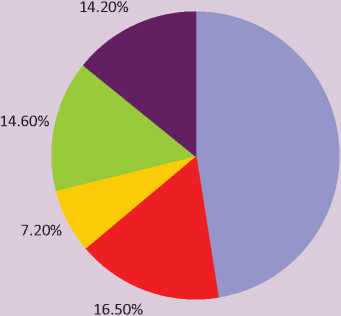
47.50%
Wholesale and retail trade repairing of motor vehicles, household goods and personal items
Construction
Real estate, renting and provision of services
Transport and communications
Other types
Figure 2. The highest priority types of economic activity in the small-scale business in the Yamalia-Nenetsia Autonomous Okrug in 2010 (the share of small enterprises)
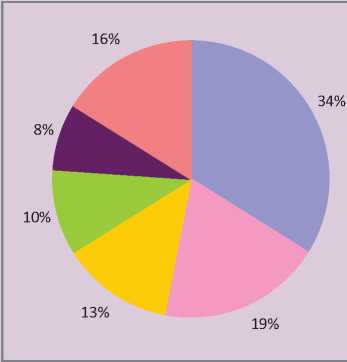
■ Construction
■ Wholesale and retail trade, personal services
■ Real estate
■ Transport and communications
■ Manufacturing activity
■ Other types
It should be noted that most of the smallscale enterprises in the Khantia-Mansia Autonomous Okrug are engaged in trade and public services. Most of the small-scale enterprises in the Yamalia-Nenetsia Autonomous Okrug are occupied with the construction.
There is a positive dynamics of main indicators characterizing the activity of smallscale enterprises in the Khantia-Mansia Autonomous Okrug.
The most important indicator reflecting the size of small-scale business is a number of small-scale enterprises operating in the autonomous okrug. It increased from 4900 in 2005 to 11700 small-scale enterprises in 2010 (by 2.4 times) (fig. 3) .
Average number of employees in the smallscale enterprises including microenterprises was 90800 people in 2010. It increased by 86.1% as compared with 48800 people in 2005 (fig. 4) .
Figure 3. Dynamics of number of small-scale enterprises registered in the Khantia-Mansia Autonomous Okrug – Ugra
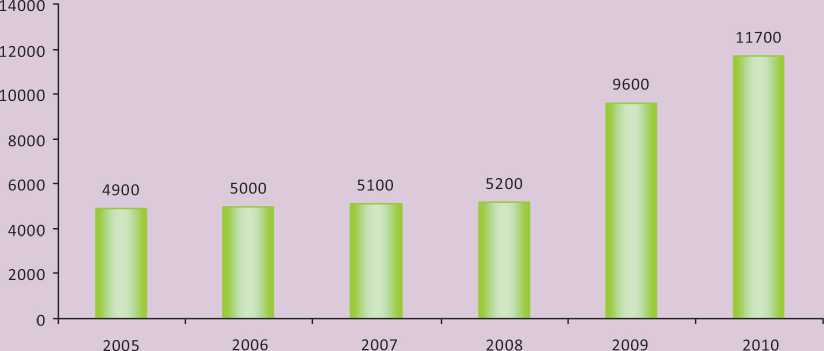
О Number of small-scale enterprises, units
Figure 4. Average number of employees in the small-scale enterprises including microenterprises in the Khantia-Mansia Autonomous Okrug – Ugra
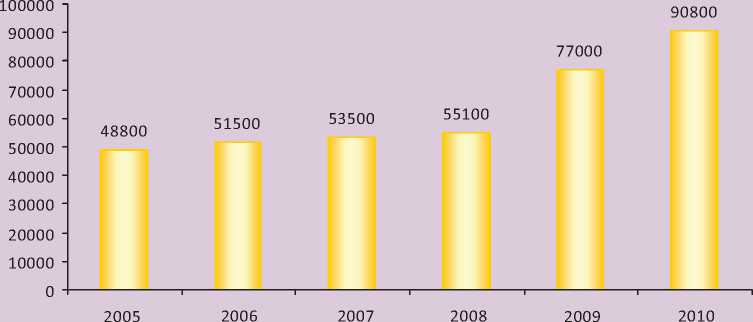
□ Average number of employees in the small-scale enterprises
Figure 5. The growth of consumer demand in the personal services sector in the Khantia-Mansia Autonomous Okrug – Ugra in 2010 as compared with 2009
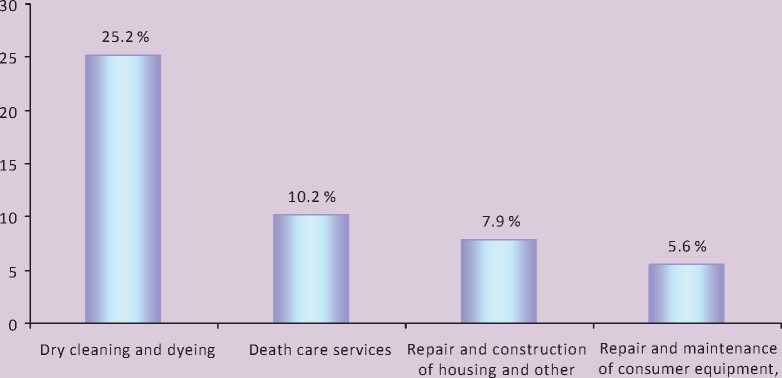
buildings household machines and appliances
The number of registered sole traders in the territory of the autonomous okrug increased by 19.4% (from 41290 in 2005 to 49300 in 2010).
Cost of the personal services which were rendered to the population in this okrug in the period from January till July in 2010 was 2075.3 million rubles. At constant prices the volume of public services increased be 2.5% as compared with the same period in 2009.
In the sphere of public services the strongest growth of consumer demand was on the following services in 2010 as compared with 2009:
-
• dry cleaning and dyeing – 25.2%;
-
• death care services – 10.2%;
-
• repair and construction of housing and other buildings – 7.9%;
-
• repair and maintenance of consumer equipment, household machines and appliances – 5.6% (fig. 5) .
Figure 6. The volume of the small-scale enterprises’ turnover by the types of economic activity in the Khantia-Mansia Autonomous Okrug – Ugra in 2009 – 2010 (million rubles)
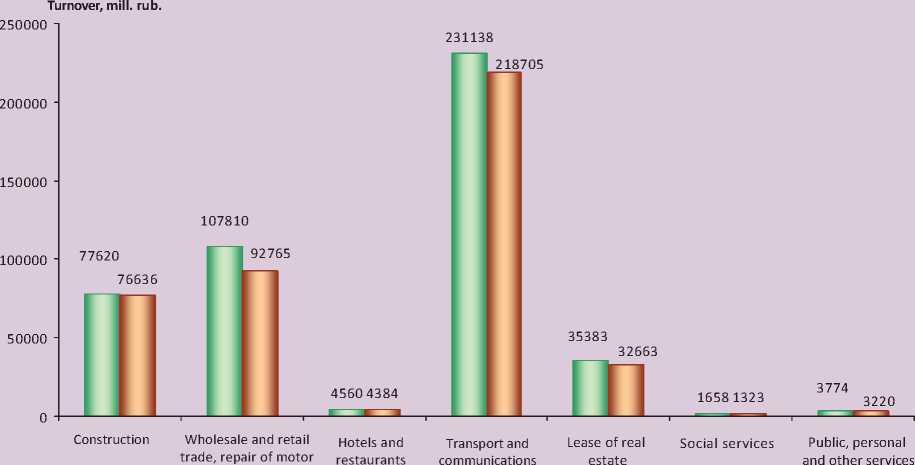
vehicles and household
goods
□ 2010 □ 2009
Type of activity
In the structure of the small enterprises’ turnover by the types of economic activity the bulk of turnover is the share of transport and communications (218705 million rubles – in 2009; 231138 – million rubles – in 2010), wholesale and retail trade, repair of motor vehicles and household goods (92765 million rubles – in 2009; 107810 million rubles – in 2010), as well as the construction (76636 million rubles – in 2009; 77620 million rubles – in 2010) (fig.6) .
In general, the turnover of small-scale enterprises increased by 2.6% in 2010. It was 246.2 billion rubles at the end of 2010 as compared with 240.0 billion rubles in 2009.
However, there was a significant decrease in consolidated funds aimed to support the small and medium-sized enterprises by 29.4% in 2010 as compared with 2009. Financing of business from the autonomous okrug’s budget decreased by 54.7% in 2010 as compared with 2009.
The total funds aimed to support the small and medium-sized enterprises amounted to 1.2 billion rubles in 2010 including 292.3 million rubles from the funds of autonomous okrug. It amounted to 1.7 billion rubles in 2009 including 645.5 million rubles from the okrug’s budget (fig. 7) .
The amount of subsidies to support the small-scale businesses in the autonomous okrug was set at the rate of 198.4 million rubles for the Khantia-Mansia Autonomous Okrug at the cost of the federal budget in January-December in 2009, including:
-
• implementation of the programs to support the nascent entrepreneurs in the form of grants to establish their own business – 5.0 million rubles (2.5%);
-
• supporting of the small-scale business by the guaranteeing funds – 131.6 million rubles (66.3%);
-
• supporting of the small-scale business by microfinance – 41.8 million rubles (21.1%);
Figure 7. Amount of financing aimed to support the small and medium-sized enterprises in the Khantia-Mansia Autonomous Okrug – Ugra in 2009 – 2010
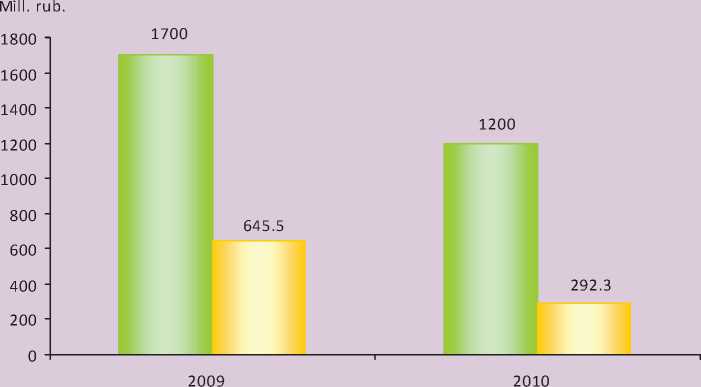
Consolidated amount of funds KMAO budget funds
-
• compensation for the payment of the interest rates on credits by the subjects of the small-scale business – 20 million rubles (10.1%) (fig. 8) .
The amount of subsidies from the federal budget to support the small-scale business declined significantly in 2010; it accounted for 105.5 million rubles, including:
-
• implementation of the programs to support the nascent entrepreneurs in the form of grants to establish their own business – 20.0 million rubles (18.9%);
-
• supporting of the small-scale business by microfinance – 70.0 million rubles (66.4%);
-
• compensation for the staff’s education expenditures of the company – 4 million rubles (3.8%);
-
• compensation for business incubation costs of the company – 1.5 million rubles (1.4%);
-
• compensation for the payment of the interest rates on credits by the subjects of the small-scale business – 10 million rubles (9.5%) (fig. 9) .
Analysis of the distribution of subsidies from the federal budget to the main areas of supporting of the small-scale business showed that in 2009 the bulk of subsidies were aimed to support the entrepreneurship from the guarantee funds as well as to support the smallscale business by microfinance. Supporting of the small-scale business by microfinance was priority in 2010. The largest part of subsidies was concentrated in that area. Compensation for the payment of the interest rates on credits by the subjects of the small-scale business was also in the forefront. In connection with the above analysis, in our opinion the main problems of the small-scale business development in the autonomous okrug are the following:
-
> concentration of the major share of small enterprises in wholesale and retail trade while the share of the construction sector accounts for a few small businesses, despite the fact that today regional demand for living accommodation exceeds the provision of the okrug with accommodation.
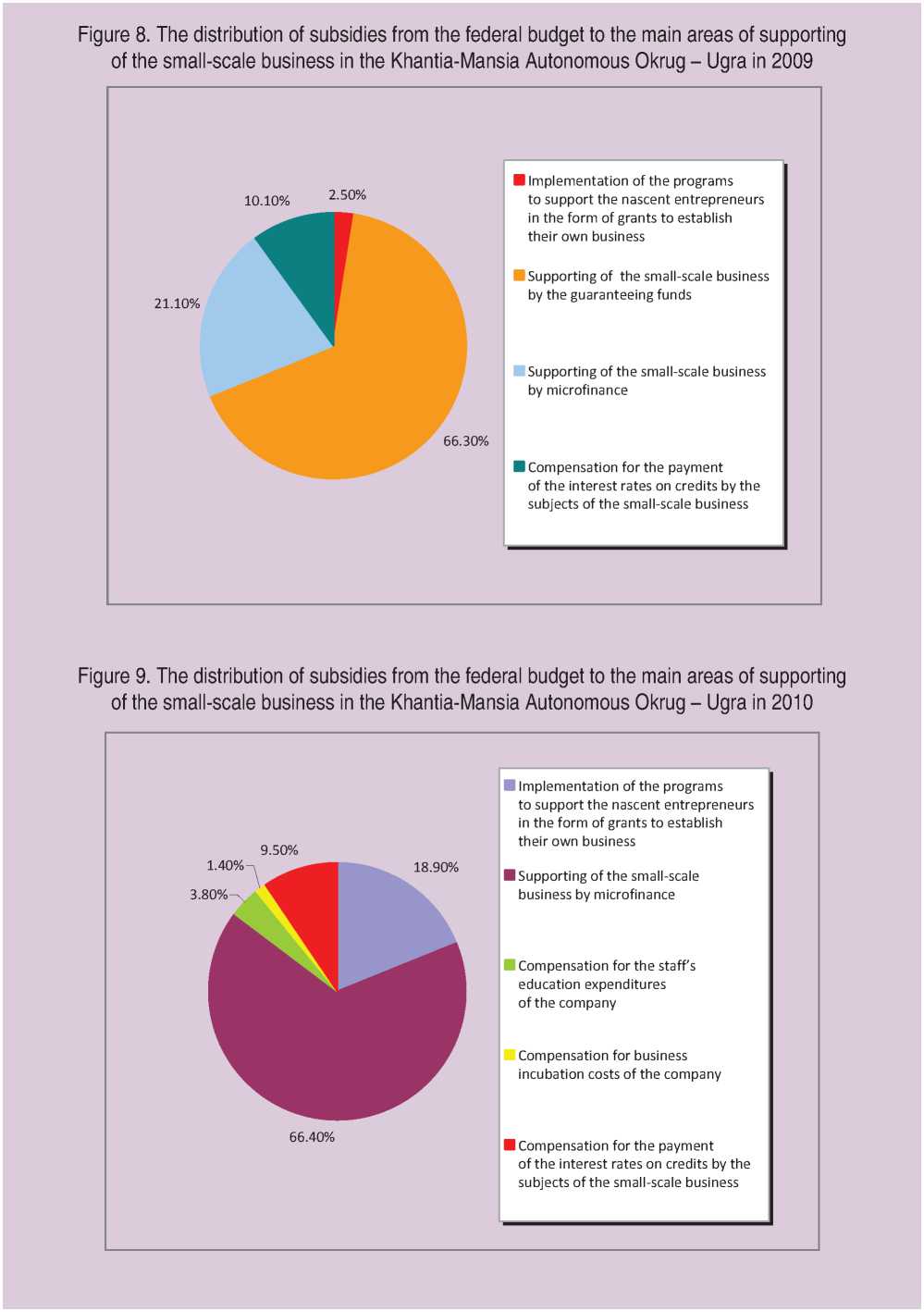
-
> entrepreneurs invest only those industries that can operate with the minimum capital stock and that can produce quick returns;
-
> modern small-scale business in the okrug is timed to the construction, trade, real estate, service delivery while there is lack of small-scale enterprises in deep timber processing, productive services for oil, gas and timber companies and agrarian service;
-
> there are few companies providing such intelligent services for the enterprises of basic economic sectors as consulting service and design work;
-
> the regional small-scale enterprises are weakly involved in the foreign economic activity;
-
> a significant reduction in the amount of funds to support the small-scale enterprises: financing from the okrug’s budget declined by 54.7% in 2010 as compared with 2009; the amount of subsidies from the federal budget to support the small-scale business also declined by 88%;
-
> lack of industrial and office premises for business;
-
> lack of own financial resources in the small-scale business.
The Government of the autonomous okrug has developed and adopted the target program “Development of small and medium-sized businesses in the Khantia-Mansia Autonomous Okrug – Ugra in 2011 – 2013 and for the period till 2015” to solve the existing problems of the small-scale business development as well as to enhance the role of small and medium enterprises in the economy of the okrug.
The major program activities offered by public authorities in the autonomous okrug are the following:
Э improving of the normative legal base governing the business activity in the autonomous okrug;
Э monitoring and information support of the small-scale business activities;
Э modernization and arrangement of conditions for introduction of power efficient technologies in the small-scale enterprises;
Э promotion of the development of young people's entrepreneurship;
Э promotion of innovative activity of the small-scale enterprises;
Э arrangement of conditions for the development of small-scale business in the field of ecology and traditional crafts;
Э improving of mechanisms of financial and ownership support;
Э arrangement of conditions for promotion of goods and services of local producers.
The largest part of the Program’s funds will be spent to improve the mechanisms of financial and ownership support (1353430 thousand rubles), promotion of the development of young people's entrepreneurship (18850 thousand rubles), arrangement of conditions for the development of small-scale business in the field of ecology and traditional crafts (18270 thousand rubles).
In our opinion, the most promising areas of small business development are the following: the introduction of power efficient technologies in the small-scale enterprises, the development of small-scale business in the field of ecology and arrangement of conditions for promotion of goods and services of local producers.
We think that the support of the small-scale business by the Government of the autonomous okrug can’t be across-the-board because of the limited budgetary resources; it should be fairly selective in accordance with clearly defined areas.
There are three main factors influencing over the development of small and mediumsized businesses and increasing of their share in the regional economy in the analytical report “The development of the small and mediumsized enterprises in the regions of Russia. Indexes of SUPPORT”. It was prepared in 2008 by All-Russian public organization of the small and medium-sized businesses “Support of Russia”. The factors are the following:
-
1. Demand conditions in the region.
-
2. Specificity of the sectoral structure of the regional economy.
-
3. Regional business climate as a set of conditions for the development of the small and medium-sized businesses in the region.
If we consider these factors in relation to the Khantia-Mansia Autonomous Okrug it should be noted that the okrug has a low level of demand for the products. The absence of large urban agglomerations is not conducive to the formation of a single large local consumer market for the full range of paid services, so the formation the services market in the autonomous okrug can’t be as quickly as in the major cities of the country.
The specificity of the branch structure is characterized by a lack of the economic diversification, most of which falls on the share of the fuel and energy balance complex.
The first two factors are basic; they are difficult to change.
The third factor (the regional business climate) can be changed. The regional authorities should strive to create the most favorable conditions for the small-scale business development in the region through such means of support as: microfinance, reimbursement of the interest bank rate, commitment insurance arrangements, consulting if the organizations, seminars and exhibitions.
We think that the main areas of the smallscale business support should include:
-
• support of productive and innovative activity of the regional entrepreneurs;
-
• arrangement of conditions for the development of the small-scale business in the rural areas;
-
• involvement of non-state forms to support the small-scale business: mutual lending and mutual insurance which can compensate for the lack of financial resources of individual small businesses;
-
• support of the factories using resourcesaving technologies and working on the base of the by-products and wastes;
-
• support of the development of financial leasing as a pillar of stability of the small-scale businesses;
-
• the procedure of business starting is notification;
-
• the development of public and private partnership.
Summarizing the study, it should be noted that the Khantia-Mansia Autonomous Okrug is characterized by the positive dynamics of the main economic indicators which reflect the state of the small-scale business. Created conditions for the development of the smallscale enterprises in the region have improved the business activity. However, the Government of the autonomous okrug should take into account the limited budgetary resources and support the small-scale business in accordance with clearly defined directions to maintain the existing positive trends in the development of the small-scale business in the territory of the autonomous okrug. Today there are the following important areas: diversification of the small-scale businesses, arrangement of conditions for the development of the small-scale business in the rural areas and involvement of non-state forms to support the small-scale business.
The development of the small-scale business in the Khantia-Mansia Autonomous Okrug is taking on political, social and economic value. The formation of middle-class owners is a base of stability. It promotes the creation of new jobs, expands the tax base and improves the quality of life.
Список литературы Actual problems of small business development in the Khantia-Mansia autonomous okrug - Ugra
- Laws of the Khantia-Mansia Autonomous Okrug -Ugra “About the Program of the state support of the small-scale business in the the Khantia-Mansia Autonomous Okrug -Ugra in 2004 -2010” dated 30.12.2003, № 82 (as amended on October 2, 2008).
- Laws of the Yamalia-Nenetsia Autonomous Okrug “About the district target program “The development of the small and medium-sized businesses in the Yamalia-Nenetsia Autonomous Okrug in 2008 -2010”.
- The Resolution by the Government of the Khantia-Mansia Autonomous Okrug -Ugra “About the target program of the Khantia-Mansia Autonomous Okrug “The development of the small and medium-sized businesses in the Khantia-Mansia Autonomous Okrug in 2011 -2013 and for the period till 2015” 10.09.2010, № 241-p.
- State and municipal management of Ugra. -Vol. 2: Economics and business administration. -Khanty-Mansiysk, 2007.
- Kurikov, V.M. Window to Ugra: Atlas-Travel Guide, 1930 -2005/V.M. Kurikov. -Khanty-Mansiysk: Zebra, 2005. -447 p.
- The small-scale business of Ugra-2005: Information Analysis yearbook. -Khanty-Mansiysk: LLC “The Ideal”, 2006. -84 p.
- Rakutina, N.M. Modern Problems of the Russian small-scale business/N.M. Rakutina//Nat. projects. -2010. -№12. -Pp. 83-90.
- Sapunov, M.K. Great expectations of the small-scale business/M.K. Sapunov//Money and credit. -2009. -№5. -Pp. 53-55.
- Serga, L.K. Power and small-scale business: voluntary serfdom or contemporary problem-solving/L.K. Serga//Vestnik NSUEM. -2009. -№ 2. -Pp. 79-84.
- Social and economic situation in the Khantia-Mansia Autonomous Okrug -Ugra in January -July, 2010: statistical report/Regional office of the Federal State Statistics Service of the the Khantia-Mansia Autonomous Okrug -Ugra -Khanty-Mansiysk, 2010. -103 p.
- Ugra: horizons of the present/Information-analytical anthology. -Khanty-Mansiysk: Socrates, 2005 -2006.

